History of Tver
Tver in the 12th-16th centuries
Tver has a rich history dating back to the first half of the 12th century. Officially, the year of foundation of the city is 1135. According to archaeological data, a settlement on the cape at the confluence of the T’maka River with the Volga existed already in the 9th-10th centuries. In the 12th century, it was a small trading settlement. The first birch bark letter, found in Tver on the territory of the old Tver Kremlin, dates back to 1200-1220.
In the first third of the 13th century, Tver was part of the Principality of Pereyaslavl. In 1238, the town was ravaged by the Mongols, but quickly recovered from the defeat. In 1247, Tver became the capital of the Principality of Tver.
The geographical position of Tver on an important trade route connecting Novgorod with northeastern Russia, and the relative remoteness from the Golden Horde contributed to the influx of population from other Russian lands into the region. The growth of Tver was also caused by the change in its political role. In 1264, Prince Yaroslav of Tver became the Grand Duke of Vladimir, but stayed to live in Tver.
Chronicles and stone construction were resumed in Tver for the first time in Rus after a 50-year hiatus. Tver developed its own original art school: architecture, icon painting, jewelry, decorative and applied arts. Its own coin was also minted here.
More Historical Facts…
In the summer of 1327, after the arrival of the khan’s ambassador Shevkal in Tver, rumors spread about the imminent conversion of the residents of Tver to Islam. A powerful uprising broke out in the town. With the help of Ivan Kalita, Grand Duke of Moscow, it was brutally suppressed; Tver was ruined. The suppression of the uprising marked the beginning of the decline of Tver.
Until the second half of the 15th century, Tver was subjected to repeated attacks by the Mongols and Moscow. In this struggle, Tver gradually lost its leading position among the old principalities of North-Eastern Russia. Moscow became the unifier of the Russian lands. This struggle undermined the strength of Tver. However, in the 14th-15th centuries, it remained a large trade, craft, and cultural center, one of the most developed Russian towns. In 1485, Moscow troops occupied Tver, the Tver Principality ceased to exist and became part of the emerging Russian centralized state.
In the 16th century, the oldest surviving church in Tver, the Trinity Church, known as the White Trinity, was built. In December 1569, Tver was plundered by the oprichnina army of Ivan IV the Terrible during his campaign against Novgorod.
Tver in the 17th-19th centuries
At the beginning of the 17th century, about 10,000 people lived in Tver. In 1612, during the Time of Troubles, it was completely devastated by the Polish-Lithuanian troops. In 1629, the town had 11 abandoned churches and monasteries, 1,450 empty houses. In 1685, its population was about 4,600 residents.
In the 18th century, after the founding of St. Petersburg, Tver became an important communication point between the new capital of Russia and Moscow. In 1701, by order of Peter I, a floating bridge on rafts was built in Tver, which existed until 1900. By 1709, the construction of the Vyshnevolotsk water system was completed, which connected the Volga with the Baltic Sea.
A lot of civil buildings were constructed in Tver. Many of them have survived to this day. The oldest of them is considered to be the house of the merchant Arefiev, which houses the museum of Tver everyday life now.
In 1763, a fire destroyed the central part of Tver. The main features of the new regular planning of the town were the long axial Millionnaya (Sovetskaya) Street, named so because a million rubles were allocated for the construction of stone houses in the town center; as well as the “Versailles trident” - a three-rayed composition of streets converging at one point, modeled on a similar urban planning technique used in St. Petersburg.
In 1764-1766, the main attraction of Tver was constructed - the Travel Palace of Empress Catherine in the style of classicism with baroque elements, designed by M.F. Kazakov. The palace was intended for the rest of the members of the imperial family on the way from St. Petersburg to Moscow. In 1787, the population of Tver was about 15,100 people.
In 1851, Tver was connected with St. Petersburg and Moscow by the Nikolaev railway. In the second half of the 19th century, a steamship society, a weaving manufactory, a mechanical plant for the production of parts for textile machines, sawmills, and other enterprises were opened in Tver. In 1850-1860, three textile factories were founded in Tver.
Tver in the 20th century and beyond
In 1900, a permanent bridge across the Volga River was built in Tver, designed by the Czech engineer L. Mashek. In 1914, the population of Tver was 63,900 people. With the outbreak of the First World War, the Russian Empire experienced problems in exchanging information with its allies - France and the British Empire, since most of the European land lines passed through the German Empire. The key role in the exchange of information between the allies was played by the Tver special purpose radio station of the Russian military department. During the war, the Russian-Baltic Carriage Works were evacuated to Tver from Riga.
In the 1920s-1930s, dozens of churches, architectural monuments of the 17th-19th centuries, were closed and destroyed in the city. On November 20, 1931, Tver was renamed Kalinin, in honor of M.I. Kalinin, the Soviet party and statesman, a native of the Tver Governorate. In 1935, Kalinin became the administrative center of Kalinin Oblast. The population of the city was 216,131 people in 1939.
On October 17, 1941, during the Second World War, the city was captured by the Germans, however, their further advance was delayed, and in the northwest direction it was completely stopped. It was under German occupation for about two months. During the occupation and heavy fighting, the city was badly damaged, more than half of the residential buildings and about 70 enterprises were destroyed. Until the liberation of Rzhev (March 3, 1943), Kalinin was subjected to systematic raids by German aircraft.
On November 1, 1945, a decree was adopted on the priority restoration of 15 most important cities of Russia destroyed during the war, including the city of Kalinin. In the 1950s-1960s, magnificent buildings in the style of Stalinist classicism were erected: the drama theater (1951), the library named after M. Gorky, the technical school on Lenin Avenue (1957), the ensembles of Novopromyshlennaya Square, Peace Square, Gagarin Square.
In the second half of the 20th century, an electrical equipment plant, a chemical fiber plant, a silicate brick plant, a silk-weaving factory, a meat processing plant, a pharmaceutical factory, a fiberglass plant, etc. were opened in Kalinin. It became not only a large industrial city, but also an important transport hub. In 1961, a river port and a circular highway were opened here, connecting highways to Moscow, Leningrad, Rzhev, and Volokolamsk.
In 1989, the population of Tver was 450,941 people. By the early 1990s, there were about 80 industrial enterprises of 28 industries, 5 universities, 3 theaters, 12 movie theaters, 8 palaces of culture in Kalinin. On July 17, 1990, the historical name and coat of arms were returned to the city.
Due to the negative economic consequences caused by the collapse of the Soviet Union, active development in the city temporarily ceased. The only new microdistrict built in the 1990s-2000s was the microdistrict Mamulino, built for the withdrawal of a contingent of Soviet troops from East Germany in 1993.
The new economic reality turned out to be disastrous for the local industry, especially the light one, traditional for the city, as a result of which the largest enterprises of Tver stopped their work, which caused an increase in the level of unemployment and social tension.
In the mid-2000s, large-scale housing construction resumed in Tver, active construction of public buildings, shopping and entertainment centers began. At the same time, new industrial enterprises were commissioned.
Architecture of Tver
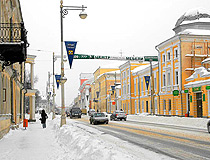
Winter in Tver
Author: Andrey Dmitriev
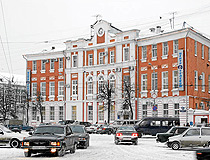
Tver architecture
Author: Andrey Dmitriev
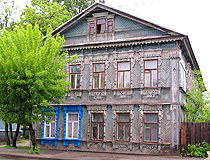
Wooden architecture in Tver
Author: Alexandra Kilanova
Tver - Features
There are several versions about the etymology of the name of Tver. According to one of them, it was named after the Tvertsa River, and Tvertsa, in turn, is derived from the Finnish word “tiort” (“fast”). According to another version, the name of the city comes from the Slavic “tverd” (“fortress”). In addition, this name is associated with the Polish word “twierdza” (“fortress”) and the Lithuanian words “tvora” (“fence”) and “tverti” (“to enclose”).
Tver is located at the intersection of the railway and highway connecting Moscow and St. Petersburg with the Volga in its upper reaches; about 180 km north-west of Moscow and 520 km south-east of St. Petersburg. The City Day of Tver is celebrated on the last Saturday of June.
The climate in Tver is moderately continental, with cold and rather long winters and warm, humid summers. The average temperature in February is minus 8.3 degrees Celsius, in July - plus 19.8 degrees Celsius.
The coat of arms of Tver corresponds to the historical coat of arms of Tver approved by Empress Catherine II in 1780 with the following description: “In a red field, on a green pillow, a golden crown”.
Tver is one of the largest industrial centers in Russia. The main industrial sectors of the city are mechanical engineering, printing, and food processing. A characteristic feature of local machine building is its concentration in one enterprise: Tver Carriage Works (the largest employer in Tver with more than 8 thousand employees).
Today, Tver is an important tourist center of Russia. The city has preserved a lot of historical mansions of the 18th century, with which almost the entire Volga embankment is built up. The restored churches of the 17th century are also of great interest.
The Volga River is worth a separate mention. Within the limits of Tver, its banks are dressed in picturesque embankments, where comfortable areas for recreation and walking have been created.
Main Attractions of Tver
Tver Imperial Travel Palace (1764-1766) - an architectural monument in the classicism style with baroque elements, which is located on Cathedral Square in the historical center of Tver. The palace was intended for the rest of the members of the imperial family on the way from St. Petersburg to Moscow. Today, this palace is not only an object of historical and cultural heritage, but also one of the oldest buildings in Tver.
Today, the Tver Imperial Travel Palace houses the Tver Picture Gallery. The art collection of the gallery numbers about 32,000 exhibits: collections of cult (“Old Russian”) art of the 14th-20th centuries, Russian painting, graphics and sculpture of the 18th-20th centuries, Western European art of the 15th-20th centuries, decorative and applied art of Russia, Europe, East.
Stepan Razin Embankment - one of the most interesting and popular walking places for locals and tourists in Tver, named after the famous Don Cossack. It is located on the right bank of the Volga River and stretches from the city garden to the stadium. In addition to the former merchant buildings on this embankment, there are noble mansions, “The House of Voroshilov Riflemen” - an architectural monument of the Stalinist era, and “Zvezda” (“Star”) movie theater, built in the style of late constructivism.
Afanasy Nikitin Embankment. This embankment stretches along the left bank of the Volga. There are a lot of stylized restaurants and open-air verandas here, where tourists love to drop in in the warm season. On the embankment, there are several monuments in honor of famous historical figures, as well as a city amusement park.
Trekhsvyatskaya Street - a 1.3 km long pedestrian street known as “Tver Arbat”. This is one of the most picturesque streets in Tver, built up with old houses and mansions. Almost all of the surviving buildings date from the late 19th - early 20th centuries. This beautiful and well-maintained place attracts musicians, artists, and souvenir sellers. The first floors of the buildings are given over to restaurants, cafes, and shops. All major city holidays are held here.
Sovetskaya Street - the main street of Tver stretching through the historic center of the city for 2.2 km. A lot of buildings on this street are recognized as monuments of architecture and history. Among them are the Ascension Cathedral (1751-1760) and the Tver Imperial Travel Palace, the House of the Nobility Assembly, and the building of the Drama Theater. Of the modern buildings, the Catholic Church of the Transfiguration of the Lord, which combines elements of Gothic and modernism, is of interest.
Tver State United Museum. The exposition of the museum tells about the nature of this region, its history, and archaeological finds. Here you can see antiques, learn about the history of the Tver Principality, the religion of the Slavs, get acquainted with the architecture and life of the nobles, who lived on the territory of the Tver region in the 17th-19th centuries. Sovetskaya Street, 5.
Museum of Tver Everyday Life - a small museum located in the complex of buildings of the estate of the Arefiev merchants. The exposition of the museum is devoted to the everyday life of various segments of people of the Tver Governorate and works of applied art created by urban artisans and peasants. Gor’kogo Street, 19/4.
White Trinity Church (1564) - the oldest building on the territory of Tver, constructed of white stone and brick, a monument of history and architecture. Inside, an old iconostasis has been preserved, the wall painting belongs to a later period - the 19th-20th centuries. Troitskaya Street, 38.
Resurrection Cathedral (1912-1913) - a beautiful building in the neo-Russian style, built for the 300th anniversary of the reign of the House of Romanov. The decoration of the cathedral is stylized to resemble the forms of Pskov and Novgorod architecture. Barrikadnaya Street, 1.
Tver Mosque (1906). Due to its bright and very unusual appearance, this mosque is deservedly one of the main architectural attractions of Tver. The building was constructed in neo-Moorish style with semicircular arches on the ground floor and a scalloped ridge on the roof. Sovetskaya Street, 63.
Not far from the mosque, there is an observation deck “Panorama” (Smolensky Lane, 29), where you can enjoy the views of the old Tver and the Volga River from the height of the 24th floor.
Starovolzhsky Bridge (1900) - the first permanent bridge across the Volga River in Tver, connecting Afanasy Nikitin Embankment on one side with the City Garden on the other. The openwork spans of this bridge look like the famous Liberty Bridge in Budapest. It is one of the main sights of the city.


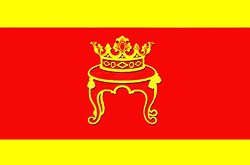
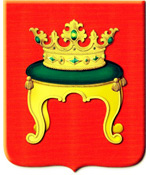
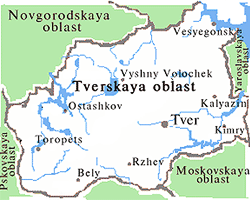



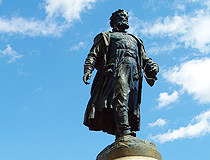
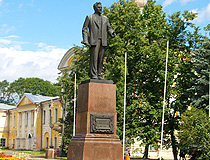
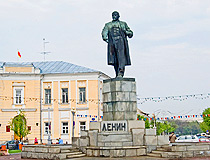
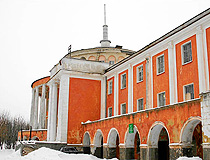
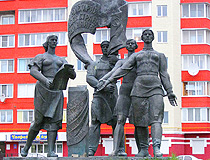
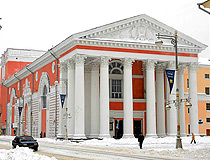
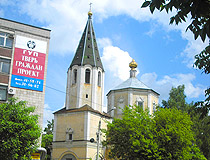
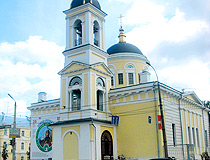
The comments of our visitors